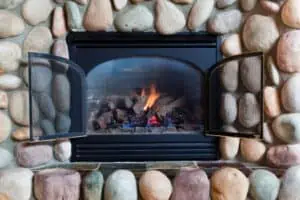How Does Ventless Fireplace Work?
Compared to vented fireplaces, ventless fireplaces don’t require a flue, chimney, or an external air intake. Instead, the flames of the fire are channeled through holes in noncombustible artificial logs. This gives the illusion of a real wood-burning fireplace. However, it does leave behind fumes and byproducts, which can be dangerous to your health.
(Searching in Google “corner gas fireplace“? Contact us today!)

For a typical gas fireplace, you’ll have a vent at the top of the unit. These are usually lined with fireproof material. In addition, you’ll have a control panel on the inside, which controls the flames.
Another feature you’ll want to look for is an Oxygen Depletion Sensor (ODS), which is a small electronic device that detects the presence of oxygen in a room. If there isn’t enough, the device will automatically shut the fireplace off.
Several manufacturers include the ODS in their ventless fireplaces. These devices are not meant to last forever though. That’s why manufacturers advise customers to keep windows open while the fireplace is running.
Other features include battery-assisted ignition and remote control capabilities. Some models are also equipped with glowing embers or sand granules. In addition, some models use colored fire-safe glass pieces or alcohol gel cartridges.
Ventless fireplaces can be a good source of heat, but they can also increase the humidity in a home. Some models have built-in sensors to measure the room’s temperature, which allows them to turn the fireplace off when the air gets too hot. Some manufacturers even recommend leaving a window cracked while the fireplace is running. But in the colder months, this may not be possible.
Some contractors also recommend installing ductwork to manage emissions from the fireplace. If you are concerned about your family’s safety, it’s best to have a professional do it for you. In addition to ensuring your family’s safety, a reputable contractor will know how to install your vent-free gas fireplace correctly.
If you’re considering purchasing a ventless fireplace, make sure to do your research first. Check with your local building codes to find out what you’re allowed to install. Many states have specific regulations regarding the installation of these fireplaces. If you’re in the market for a new fireplace, take the time to find out about the pros and cons of each model.
Some types of ventless fireplaces will require the services of a plumber. They should be installed by someone with training in the proper installation techniques. If you have an existing fireplace, it’s also a good idea to hire a licensed electrician to make sure the unit is properly wired.
If you decide to go with a ventless fireplace, it’s a good idea to get a carbon monoxide detector. Carbon monoxide poisoning can have serious health effects, including death at high levels. But it can be difficult to recognize the symptoms. In the early stages, the symptoms might feel like a cold. If you have a respiratory problem, you should avoid ventless fireplaces altogether.
Some ventless fireplaces also use a battery-assisted ignition system. This can be a helpful feature for those who don’t have the time to light a fire manually.

